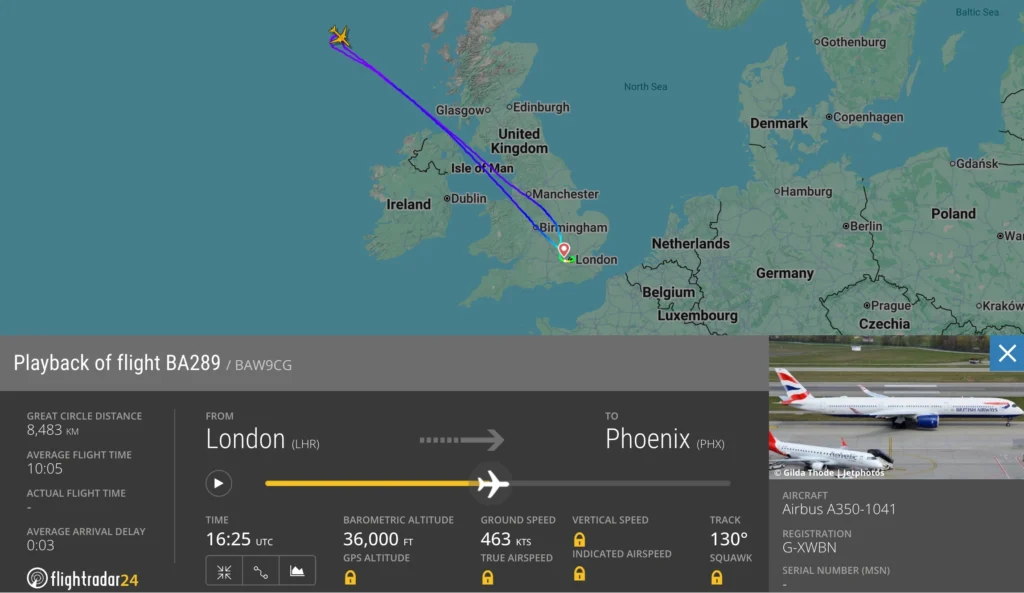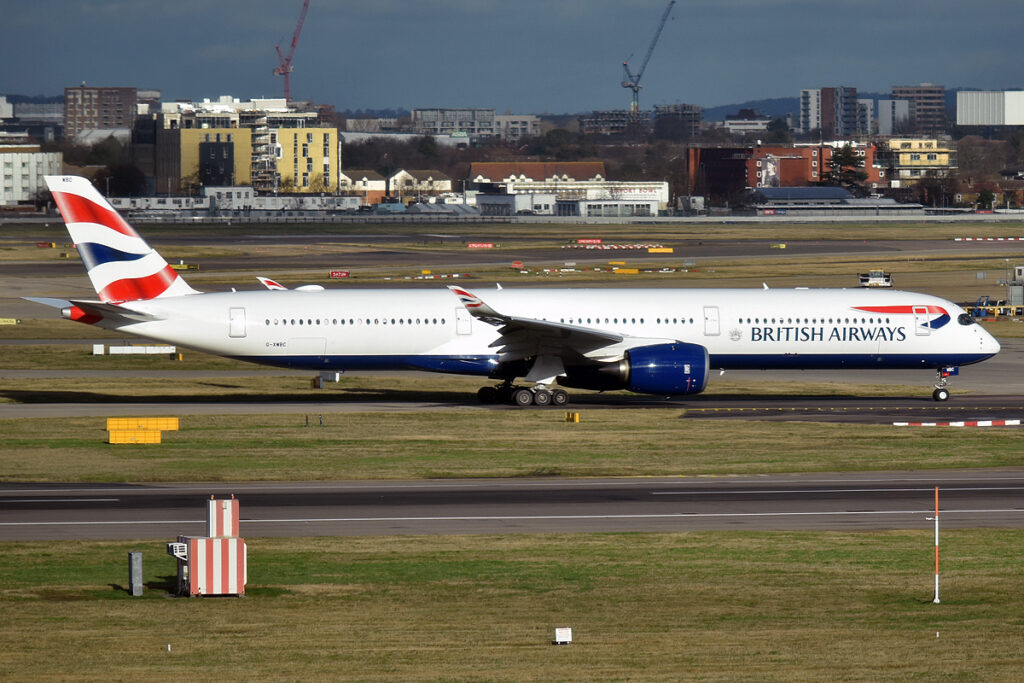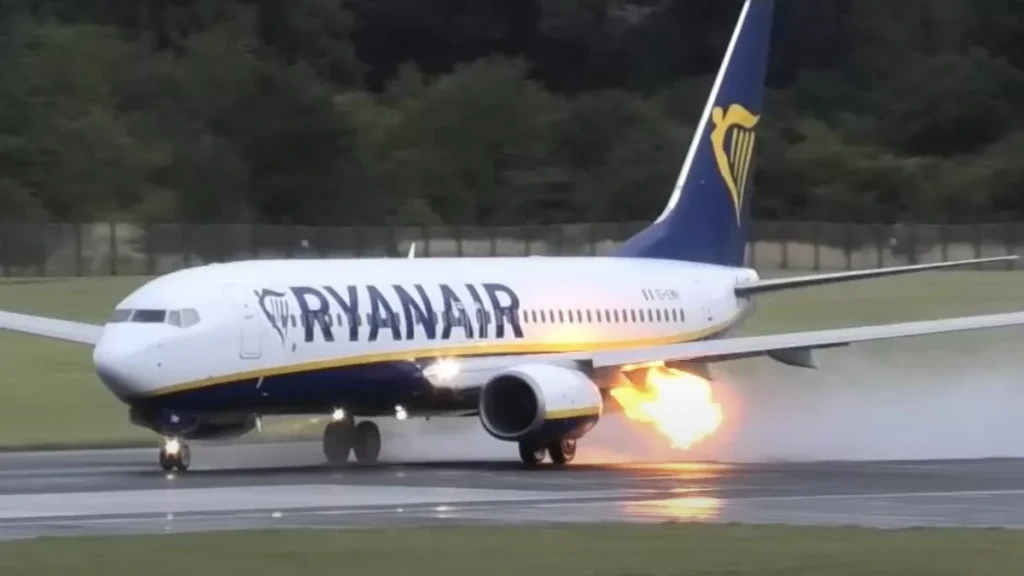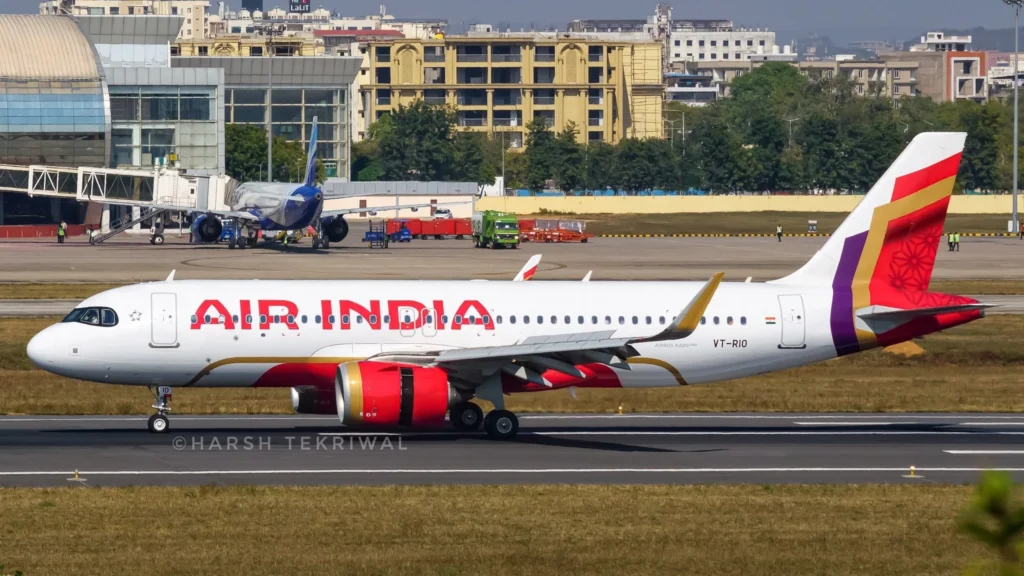
LONDON— British Airways (BA) flight BA289 from London Heathrow (LHR) to Phoenix Sky Harbor (PHX) was forced to return to its departure airport shortly after takeoff on July 14, 2025.
The Airbus A350-1000 aircraft, registered G-XWBN, had already crossed into the North Atlantic when it made a sharp turn back towards the UK, ultimately diverting and landing safely at Heathrow.
 Photo: FlightRadar24
Photo: FlightRadar24British Airways Flight U-Turn
Flight BA289 departed LHR at 15:40 UTC, bound for Phoenix, Arizona. However, approximately one hour and 20 minutes into the flight, while cruising at 36,000 feet, a technical issue arose.
According to ACARS data accessed via airframes.io, the aircraft experienced a surge in Engine No. 2. Such events typically involve an abnormal or unstable airflow through the engine, which can compromise safety or performance if not addressed immediately.
The crew opted to discontinue the transatlantic crossing and initiated a return to London, maintaining a controlled descent and safe approach. The aircraft landed at 18:30 UTC, approximately three hours after departure.
This incident led to a significant disruption in British Airways’ flight schedule. The same aircraft was assigned to operate the return service from Phoenix to London (PHX–LHR), which is now delayed by one day due to the aircraft’s unexpected return and subsequent inspection.
No injuries were reported, and the aircraft landed without further incident. Passengers were either rebooked or accommodated on alternate flights as BA initiated standard recovery procedures.
 Photo: By Anna Zvereva from Tallinn, Estonia – British Airways, G-XWBC, Airbus A350-1041, CC BY-SA 2.0, https://commons.wikimedia.org/w/index.php?curid=87549663
Photo: By Anna Zvereva from Tallinn, Estonia – British Airways, G-XWBC, Airbus A350-1041, CC BY-SA 2.0, https://commons.wikimedia.org/w/index.php?curid=87549663Flight and Aircraft Status
The 2.2-year-old Airbus A350-1041, registered as G-XWBN, is among the newest additions to British Airways’ long-haul fleet.
Flight BA289 typically covers a great circle distance of 8,483 kilometers with an average duration of over 10 hours. The flight is a daily service connecting the UK to the southwestern U.S., serving both business and leisure travelers.
The aircraft is still on the ground at London Heathrow, and as per FR24 data, it is expected to operate a flight from London to Phoenix on July 16, 2025.
The airline has not released an official statement as of now, but engineering teams are expected to conduct a full inspection of the affected Rolls-Royce Trent XWB engine. In-flight engine surges are rare and treated with utmost caution to ensure compliance with safety protocols.
 Photo: Robert Pittuck
Photo: Robert PittuckWhat Is an Engine Surge in a Jet Engine?
Despite the term “surge” suggesting an increase in speed, in the context of jet engines, an engine surge refers to a compressor stall — a breakdown in the normal airflow through the engine’s compressor.
Understanding the Surge Phenomenon
In a jet engine, the compressor uses rotating blades (airfoils) to compress incoming air before combustion. These blades rely on a precise angle of airflow. When that angle is disrupted — due to factors like sudden maneuvers, foreign object ingestion, or aggressive throttle changes — the airflow can become unstable. This causes the compressor to stall, and the built-up pressure may reverse momentarily, resulting in what’s known as an engine surge.
What Happens During a Surge?
During a surge:
- The compressor may rapidly increase in RPM as it loses aerodynamic stability.
- The engine may make a loud bang, and a yellow flame can shoot from the exhaust due to an overly rich fuel-air mixture.
- Thrust can temporarily drop or fluctuate.
Recovery and Prevention
If the engine isn’t physically damaged, the surge can be corrected by:
- Reducing the throttle decreases pressure behind the compressor.
- Gradually restoring power once airflow stabilizes.
In modern jet engines, FADEC systems (Full Authority Digital Engine Control) automatically manage surge recovery. They regulate fuel flow and prevent re-surge events, often without pilot intervention.
 Photo: avgeekwithlens/ Harsh Tekriwal
Photo: avgeekwithlens/ Harsh TekriwalSimilar Incident
An Air India (AI) Airbus A320 operating flight AI2820 from Kempegowda International Airport (BLR) to Indira Gandhi International Airport (DEL) experienced an engine stall shortly after departure on January 5, 2025.
The 3.8-year-old aircraft, registered as VT-TQE and formerly part of the Vistara fleet, was powered by CFM LEAP-1A engines. Despite the incident, the crew managed a safe return to Bengaluru without declaring an emergency.
Flight AI2820, scheduled from Bengaluru (BLR) to Delhi (DEL), departed at 7:09 PM local time—over an hour behind its original schedule. At around 8,000 feet altitude, the aircraft experienced an engine stall, typically attributed to a compressor stall within the turbofan engine system.
While no emergency was declared, the flight crew informed Air Traffic Control (ATC) and requested a precautionary return to Bengaluru. The aircraft entered a holding pattern near the airport, circling for fuel burn to reduce landing weight and avoid a hard landing. It safely landed at 8:11 PM IST.
Featured Image By Clément Alloing | Instagram
Stay tuned with us. Further, follow us on social media for the latest updates.
Join us on Telegram Group for the Latest Aviation Updates. Subsequently, follow us on Google News
American Airlines A321 Makes Emergency Landing After Engine Stalled
The post British Airways London to Phoenix Flight with A350-1000 Makes U-Turn appeared first on Aviation A2Z.
















